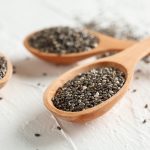Overview of PCOS: What is it?
PCOS or Polycystic Ovarian Syndrome is a hormonal imbalance that affects women during their childbearing years. Around 3.7 – 22.5% of women of this age group suffer from PCOS. Many women are unaware of this syndrome. In a research finding, up to 70% of women with PCOS hadn’t been diagnosed.
The ovaries are the reproductive organs of a woman. They are responsible for producing hormones known as estrogen and progesterone. They are responsible for regulating the menstrual cycle. Male hormones called androgens are also present in small quantities in the ovaries.
Every month the ovaries release eggs or Ovum that are fertilized by a sperm, the male reproductive cell. This process of monthly release of eggs is referred to as ovulation. The Follicle-Stimulating Hormone (FSH) and Luteinizing Hormone (LH) are responsible for controlling Ovulation. The FSH stimulates the ovary to produce the egg whereas the LH stimulates the ovary to release it. When the amount of male hormones increases or there are cyst formations in the ovaries, it is termed as Polycystic Ovarian Syndrome. It affects the ovulation and therefore, the menstrual cycle, which then becomes erratic or irregular.
Polycystic Ovarian Syndrome or a group of symptoms affects ovulation. The word ‘polycystic’ means ‘many cysts.’ Tiny fluid-filled sacs or cysts grow inside the ovaries, each containing an immature egg. The eggs never reach the stage of maturity, and hence, do not ovulate.
The absence of ovulation affects the progesterone, estrogen, FSH, and LH levels. Estrogen and progesterone levels are negatively impacted as their count decrease, and androgen levels go higher than usual.
Symptoms
Since women are often unaware of their symptoms, women begin discovering their PCOS only after gaining a lot of weight or having trouble conceiving. PCOS can disrupt the regularity of the menstrual cycles, leading to a fewer number of periods.
While weight gain, hair growth, acne, and dark skin patches are some of the symptoms of this condition, the most common symptoms include –

1. Irregular menstrual cycles: The absence of monthly ovulation prevents the uterine lining from shedding every month. Women with PCOS may, at times, get fewer than eight periods annually.
2. Intense bleeding: In the absence of monthly cycles, the uterine lining builds up for a longer duration and leads to heavier-than-normal bleeding.
3. Dense hair growth: Women with PCOS experience abnormal hair growth on their face and body. This condition is also known as hirsutism.
4. Acne: Androgens can cause breakouts on the face, chest, or upper back and make the skin oilier than usual.
5. Weight gain: Women suffering from PCOS are either obese or overweight.
6. Hair thinning or baldness: Hair on the scalp gets thinner, and hair fall becomes common.
7. Skin darkening: Women with PCOS witness dark patches in the body creases such as the neck, under the breasts, and groin.
8. Headaches: Hormonal changes in some women trigger headaches.
Diagnosis
Doctors diagnose PCOS if a woman has at least two or three significant symptoms, such as irregular menstrual cycles, ovarian cysts, and high androgen levels. Blood tests, a pelvic examination, and a lower abdominal ultrasound can confirm the diagnosis.
Secondary symptoms such as weight gain, acne, facial hair, and excessive body hair growth also contribute to the signs. Blood tests determine the higher-than-normal level of androgens. One can also check for insulin, cholesterol, and triglyceride to assess the risk of related conditions like diabetes and heart diseases. A pelvic examination can evaluate problems in the ovaries or other parts of the reproductive tract. An ultrasound uses sound waves to track the abnormal growth of follicles and other problems inside the uterus and ovaries.
Why Yoga Works Against PCOS and Helps to Prevent it?
Yoga is a way of life. It is not merely an exercise. It refers to a philosophy that forms the core of a lifestyle. The philosophy that yoga is based upon helps you achieve harmony with your mind and body, thoughts, and emotions – your entire being.
This holistic and harmonious way of living elevates the quality of every aspect of your life – be it healthy living, having better thoughts, a positive frame of mind, or just being content. PCOS is simply one of the lifestyle disorders that yoga can help manage and positively affect.
Precautionary Tips While Performing Yoga
Yoga has multiple health benefits. But if you are a beginner, you need to be extra careful while practicing it. Yoga is not a high-impact or high-intensity exercise, but it does require a lot of flexibility. Since it involves using all the muscles and joints in the body, you must be aware of the imminent cramps and aches. Here are a few safety measures you must take while performing yoga:
1. Use a yoga mat for all the essential asanas wherein you need to sit on the floor. It will prevent you from falling or slipping off.
2. Wear stretchable clothes to aid your flexibility. Yoga improves body flexibility, but you cannot twist or bend properly if your clothes keep posing a hurdle.
3. Do not push your limits. If you are unable to perform an asana correctly, do not push yourself too much. Listen to your body.
4. Put on some ambient, nerve-soothing music. Yoga is not just about relaxing your body but also about calming your mind and emotions. Soft, instrumental music is ideal for yoga.
5. Take a light meal, if you must, before a yoga session. Attempting a workout on a full stomach can cause nausea, vomiting, cramps, or acid reflux.
6. Yoga doesn’t make you sweat a lot, but it is essential to keep yourself hydrated. It is ideal for taking two sips of water after every asana.
7. Get the sequence right – perform asanas, pranayam, and then dhyana.
8. Keep your phone aside. Disconnect from work or stress-causing agents to reap the maximum benefits.
7 Yoga Poses for preventing PCOS
Here are seven yoga postures that can help prevent PCOS, relieve anxiety and stress:
1. Baddhakonasan or Butterfly Pose affects the groin area’s inner thighs, muscles, and abdominal cavity organs. It is noted to regulate the ovaries’ function and soothe the menstrual cycle.

2. Supta Badhakonasana or Reclining Butterfly Pose is a variation of the Baddhakonasan and is known to have similar benefits.

3. Bharadvajasana or Spinal Twist helps women with PCOS strengthen their spine and release stiffness. It eases shoulder stiffness, massages abdominal organs, and improves digestion.

4. Chakki Chalanasana, or moving the grinding wheel, has several benefits. This yoga posture massages the kidneys, liver, pancreas, and reproductive organs.

5. Padma Sadhana is a series of yoga postures – Cobra Pose, Superman Pose, Bow Pose, and Boat Pose – that work and strengthen the entire body. It is considered beneficial for women with PCOS.

6. Surya Namaskar improves blood circulation in the body, benefits the hair and skin, and substantially reduces anxiety.

7. Shavasana or Corpse Pose is a relaxing posture that marks the end of your yoga session. In PCOS, the more you relax and ease yourself, the better you feel.

4 Yoga Pranayama Exercises for preventing PCOS
Breathing is pivotal to any exercise or set of exercises. Yoga has a separate set of Pranayama or breathing exercises that concentrate on different breathing techniques. Here are four Pranayama that can help prevent PCOS.
- Yoni Mudra
It is a hand posture that represents the female vagina. Seated in a padmasana posture with hands joined in the yoni mudra and deep breathing helps manage PCOS. It regulates the functioning of your reproductive organs.

2. Nadi Shodhana
This Pranayama is the alternative to inhaling and exhaling through the nose’s nostrils in slow continuous cycles. It helps strike a balance between different hormones and the male and female energies of the body.

3. Bhramari
PCOS takes a mental toll. It is, therefore, essential to calm yourself down. Closing your eyes, placing both palms on your ears, drawing a deep breath, and exhaling slowly while humming is the best way to relax.

4. Kapalbhati
It is the best breathing exercise for weight management. This Pranayama is known to demonstrate a high impact on the abdominal muscles. It is an excellent breathing exercise for women with PCOS.

Benefits of Yoga for Prevention of PCOS
Yoga is a way of life that has been adopted worldwide to prevent and cure different ailments. It is practiced along with meditation. Practicing yoga is beneficial for managing PCOS in the following ways –
1. Yoga is preventive. Practicing it can prevent the onset of PCOS.
2. It is inexpensive and costs nothing.
3. It is non-intrusive.
4. It has no side-effects except the positive, healthy feeling.
5. It improves sex hormones that regulate menstrual cycles.
6. Yoga has a positive impact on cholesterol and insulin levels.
7. It is more effective than conventional physical exercises in improving insulin resistance, improving glucose and lipid.
8. It reduces stress and anxiety and calms your mind.
Disclaimer
These are suggested yoga asanas to prevent PCOS. This article is meant to aid your yoga practice and is not a replacement for a yoga instructor’s guidance.
As always, please do consult your Doctor/Physician before beginning with any exercise regimen. They will be in the best position to guide you about what you can or cannot do, given your age, health status, physical fitness levels, and other conditions unique to you.






